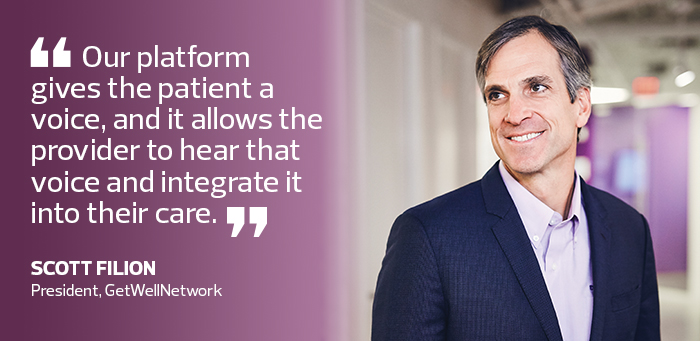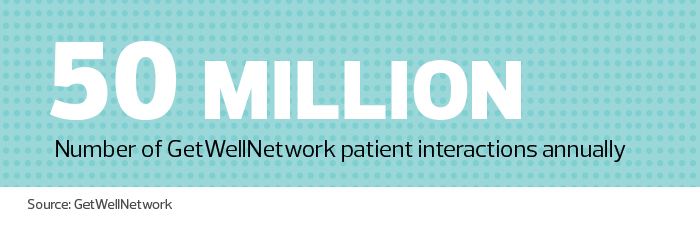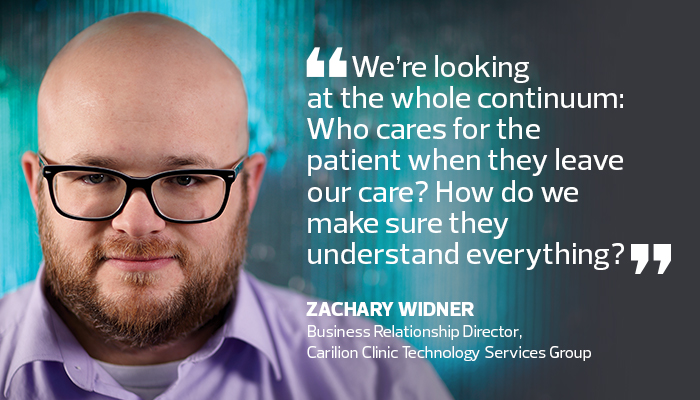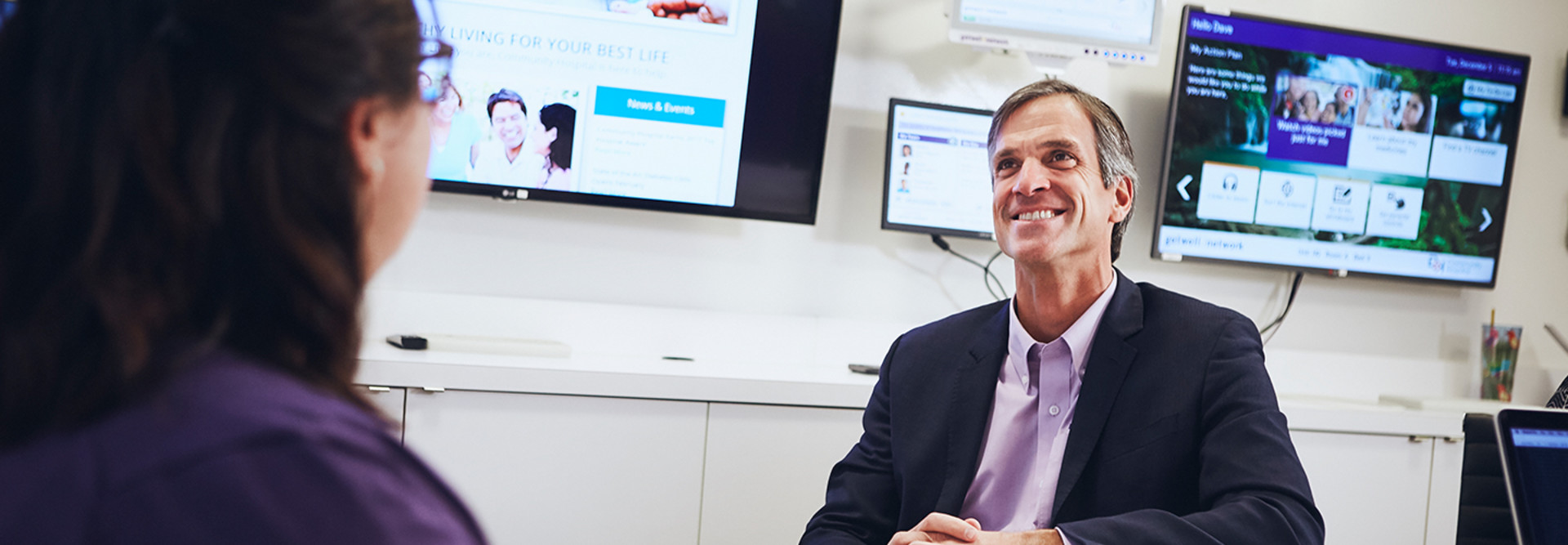GetWellNetwork: How Patient Engagement Technology Improves Care
Research shows that patients who are engaged and satisfied with their care are less likely to be readmitted to the hospital 30 days after discharge. Yet for many organizations, such engagement remains a struggle.
Improving engagement is the goal of GetWellNetwork, a Bethesda, Md., company that develops solutions specifically designed to optimize the patient experience, says President Scott Filion.
Currently used by more than 600 healthcare organizations worldwide, GetWellNetwork’s interactive suite of tools integrates with upward of 1,000 IT systems — everything from electronic health records (EHRs) to environmental control systems — enabling patients to learn about their conditions and medications, order meals, watch movies, surf the web, change the temperature in their rooms and more.
“The whole vision for GetWellNetwork is for patients to take a more active role in their care,” Filion says. “Hospitals have so much data. They have data on your insurance and your last four experiences and your labs. But what they don’t have is your voice. Our platform gives the patient a voice, and it allows the provider to hear that voice and integrate it into their care.”
Patient Engagement Technology Helps Hospitals Partner with Families on Care
While in graduate school at Georgetown University in 1999, GetWellNetwork Founder and CEO Michael O’Neil was diagnosed with non-Hodgkin lymphoma. After surgery and four cycles of chemotherapy, he was cancer-free but traumatized by his experience, which fueled creation of the company in 2000.
“I had excellent clinical care, but I felt as if it were being done to me instead of with me,” O’Neil says. “I was determined to make healthcare a better experience for other patients and their families.”
The company’s tools are presented as tiles on a screen — often 55- to 70-inch high-definition smart TVs, though organizations can use other types of devices, such as iPads — mounted at the foot of a patient’s bed.

The interface has different styles based on patient demographics. The teen interface, for instance, uses emoticons, while GetWell Town, for young patients, is a cartoon-based environment that replaces much of the text with pictures.
“It helps providers engage patients at a singular level as opposed to a one-size-fits-all approach,” Filion says.
The system gives patients the opportunity to communicate issues such as dietary restrictions, pain levels or the comfort of their rooms, and staff can address problems as they arise. Not only does that improve the patient experience, but it often translates into higher Hospital Consumer Assessment of Healthcare Providers and Systems (HCAHPS) patient satisfaction scores.
Another GetWellNetwork feature is its Interactive Digital Whiteboard that integrates with a hospital’s real-time location services. It provides patients with their daily schedule, introduces staff as they walk into the room and logs which clinicians visited the patient.
“It takes away that surprise when you’re sitting in a hospital with people coming in and out, and half the time you don’t know what they’re doing,” Filion says.
Medication Education Takes Center Stage
Carilion Clinic in Virginia rolled out the GetWell Inpatient interactive patient care system at Carilion Roanoke Memorial Hospital in September 2014 to engage patients in their healthcare. Every new patient watches a brief video welcoming them to the hospital, then staff assign other videos based on patients’ conditions, procedures, medications and other unique factors.
“Activating and engaging patients and their families is critical so that they know how to take care of themselves when they’re home,” says Kathleen Baudreau, vice president of clinical advancement and patient safety at Carilion Clinic. “We have them for such short stays nowadays that the time that we have with them has to be utilized as efficiently as possible.”
The clinical staff initiates a care pathway by assigning patients a medication education video through the Epic EHR. The system alerts the patient that a new video is available, and that he or she can watch it then or receive a reminder to watch it later.
After the video, the patient answers questions to gauge comprehension, and the system notes in the EHR that the video has been completed. Patients can also manually select resources to review again, as needed.

Another benefit is that the videos standardize messages, says Zachary Widner, business relationship director for Carilion’s Technology Services Group. When a caregiver has a full patient load and is in a crisis situation, he or she might not have time to explain all the nuances of a drug. With GetWellNetwork, the message, which is evidence-based and vetted by subject-matter experts, is the same in all circumstances.
One focus area is helping patients and families understand the medications they are prescribed. Carilion’s elderly acute-care unit focused on educating patients about their medications, and as a result saw an improvement in its HCAHPS scores regarding medication communication within three months of implementing medication review.
The rollout was so successful that Roanoke Memorial used it as a model for other units throughout the hospital. Patients can indicate if they would like bedside delivery of their discharge medications so they don’t need to stop at a pharmacy on the way home. It’s convenient for patients, and it lets providers know that patients will continue with their treatments when they leave, Baudreau says.
“We work with everybody present to make sure that they understand what’s happening,” Widner says. “We’re looking at the whole continuum: Who cares for the patient when they leave our care? How do we make sure they understand everything?”
In June, GetWellNetwork and Carilion began piloting a GetWell Go pathway for heart failure in two high-volume ambulatory clinics; GetWell Go enables patients to access information and interact with its 50-plus care pathways outside the hospital, either through a mobile app or a patient portal.
In addition to offering patients information about the condition, the pathway surveys them about their health. Based on their responses, it provides care instructions, including when to seek medical attention, and updates clinicians on their status. “GetWell Go provides a way to keep in touch with the patient and to have a consistent care plan,” Filion says.
Tech Helps Hospitals Partner with Families on Care
Following a move in 2012 to a new facility with an updated infrastructure, leaders at the Ann & Robert H. Lurie Children’s Hospital of Chicago chose to deploy GetWellNetwork tools. It initially went live with GetWell Inpatient, delivering information through two TVs in patient rooms: one to entertain children and the other for parents to access information and resources.
The system worked so well that Lurie Children’s began looking for other ways it could meet its clinical goals. The nursing leadership in the hematology/oncology and surgical units had been exploring ways to manage pain with ongoing feedback from patients and their families.

Two years later, Lurie Children's launched a multifaceted pain management program by integrating GetWellNetwork tools with both its EHR and automated medication dispensing systems.
“They had a better perspective around how to present information, how to engage families and how to partner with the clinical team to create solutions to meet their needs,” says Suma Rao-Gupta, director of the Pedersen Family Learning Center & Health Sciences Library at Lurie Children’s.
The solutions have helped to create a culture shift around how the hospital approaches and partners with families on pain management.
“You can’t measure that as well, but incorporating it into so many parts of the care process reinforces the message that pain is not this side topic,” Rao-Gupta says. “It’s meant to be something that’s constantly asked about, monitored and checked, and that you can modify with the technology. It is very much front and center.”









